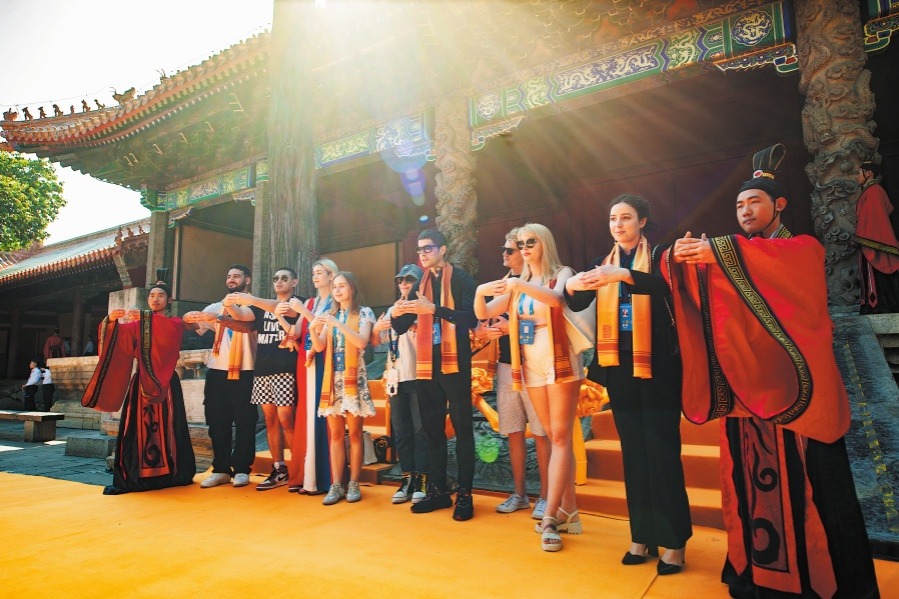Livestreamers flow overseas for sales, profits


New markets
Like Newme, a growing number of Chinese e-commerce companies are going overseas, trying to replicate the domestic success of livestreaming e-commerce in overseas markets and create a legend like Li Jiaqi.
As China's top influencer, Li sold goods worth 10.6 billion yuan ($1.53 billion) on the first day of the Double Eleven presale in 2021, and doubled it to 21.5 billion yuan last year. Double Eleven is China's biggest online shopping gala.
Last year, the nation's livestreaming market was worth more than 3.4 trillion yuan. That figure is expected to exceed 4.9 trillion yuan this year, according to the first national seminar on the high-quality development of e-commerce held in September.
"I know it's going to become something really big, like in China," said Cerrillos, who is optimistic about the future of livestreaming in the US, despite relatively low sales volumes at present.
As a former head of overseas business for Making Friends, a large Chinese e-commerce enterprise, Wang Huan has long felt the industry's enthusiasm for replicating the model overseas.
When he takes part in offline forums, the venues are usually so crowded that he can't find a seat, so he has to stand in the back row to listen. Domestic e-commerce outfits and brands keep coming to him to seek overseas experience.
Lou Xuxiao, head of Newme's office in Los Angeles, feels the same way. Whether people work in operations, branding, import-export or advertising, "as long as I post on WeChat, many of them will come and talk to me".
Many Chinese e-commerce companies have opened offices in Europe, the US, Southeast Asia and the Middle East, and some have achieved great sales.
In Indonesia, a Chinese oral care brand sold more than 2 million bottles of mouthwash in just three months starting in March last year, making it a best-seller online.
The increasingly fierce competition at home has prompted Chinese e-commerce enterprises to go overseas in search of opportunities, said Ma Zuxin, director of short-video business for Melot Group in the eastern coastal province of Zhejiang, known as the home of Chinese e-commerce.
In China, influencers chase viewers by livestreaming in Tibetan from snowy mountains for four hours to sell down jackets, while others rap and dance or act out a popular TV series in costumes from the Qing Dynasty (1644-1911) to sell skin care products.
By contrast, the overseas market is like an uncontested blue ocean for China's livestreaming companies to swim in.
"Foreign livestreaming e-commerce is at the level of China in 2018 or 2019," said Ma, whose company has recently started livestreaming in the United Kingdom, the US and Vietnam.
Leading in manufacturing, capital accumulation and livestreaming experience, Wang said that Chinese e-commerce companies "are taking a shortcut to a higher dimension".
Building a local team guided by Chinese experience is the consensus of e-commerce outfits going overseas. Like Cerrillos, all the influencers at Newme are hired locally. Wang, who moved to another Chinese e-commerce company in Southeast Asia in October, is the only Chinese national in the 18-member team.
By studying overseas' consumer habits and psychologies, some Chinese e-commerce companies even create local brands rather than exporting existing ones.
Founded in Indonesia, the Chinese makeup and skin care brand Y.O.U has become an online sales hit by empathizing with young local women, many of whom are upset about being urged to get married at family reunions during the Muslim holy month of Ramadan.
Instead, the brand encourages them to blossom into independent, assertive women.
Highly receptive to new things, the large number of young people partly explains why livestream shopping has spread across Southeast Asia in a very short space of time, Wang said. The region has a population of 620 million, the third-largest in the world, and about 45.3 percent is age 20 to 50, meaning that the demographic contains prime online consumers.
Low prices have boosted the popularity of livestream shopping in the region, too. According to Statista, a provider of market and consumer data, the top-selling products in Southeast Asia last year cost less than $25 each.
Last year, the gross merchandize volume of livestreaming e-commerce in Southeast Asia rose by 306 percent from 2021, while orders surged by 115 percent, according to data provided in June by Omise, a payment gateway for Thailand, Japan and Singapore. It predicts that a $19 billion market will develop for livestreaming e-commerce in the region this year.
"Top influencers have earned more than some celebrities," said Chinese-Indonesian Li Lina, founder of cosmetic brand Bioaqua and e-commerce enterprise Onelink. Her company has two of the top 10 influencers in Indonesia.























